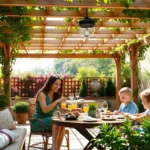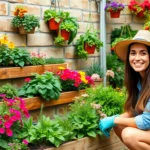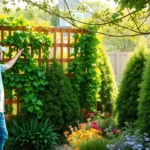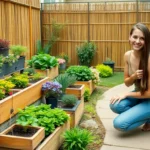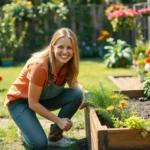We’ve all stood in our tiny front yards wondering how to transform that cramped space into something spectacular. Limited square footage doesn’t mean you have to settle for bland landscaping or give up on your dream garden entirely.
Small front yards present unique opportunities that larger spaces simply can’t offer. You can create intimate focal points that make a powerful first impression while maximizing every inch of available ground. From vertical gardens that draw the eye upward to strategic plant placement that creates the illusion of depth we’ll show you proven techniques that work.
The secret lies in smart design choices that pack maximum visual impact into minimal space. Whether you’re working with a narrow strip between your house and sidewalk or a petite patch of grass we’ve gathered creative answers that’ll make your neighbors stop and stare for all the right reasons.
Create a Welcoming Entrance With Colorful Container Gardens
Container gardens transform small front yard entrances into vibrant displays that greet visitors with instant curb appeal. We’ll show you how strategic planter placement maximizes limited space while creating stunning visual impact.
Choose Weather-Resistant Planters in Various Sizes
Fiberglass containers offer superior durability against freeze-thaw cycles and UV damage compared to traditional clay pots. These lightweight planters resist cracking in temperatures ranging from -20°F to 120°F, making them ideal for year-round outdoor use.
Ceramic glazed pots provide excellent drainage while maintaining their color vibrancy for 5-7 years with minimal fading. We recommend selecting containers in neutral tones like charcoal, cream, or terracotta that complement your home’s exterior colors.
Size variety creates visual depth when you combine large 24-inch diameter planters with medium 16-inch and small 8-inch containers. This scaling technique draws the eye naturally from ground level upward, making your entrance appear larger than its actual footprint.
Drainage holes become critical for container success, preventing root rot that kills 60% of potted plants within their first growing season. Each planter needs at least three ½-inch holes spaced evenly across the bottom surface.
Select Low-Maintenance Flowering Plants for Year-Round Appeal
Perennial selections like coneflowers, black-eyed Susans, and ornamental grasses return each season without replanting, reducing maintenance costs by 40% annually. These hardy varieties bloom for 8-12 weeks and require watering only twice weekly once established.
Evergreen shrubs such as boxwood, dwarf holly, and compact junipers maintain structure throughout winter months when flowering plants go dormant. We position these foundation plants in larger containers to anchor the overall design.
Seasonal color rotation keeps your entrance fresh by swapping out annuals like pansies, petunias, and marigolds every 3-4 months. This approach costs $30-50 per season but delivers continuous blooms and changing visual interest.
Native plant varieties adapt naturally to your local climate conditions, requiring 50% less water than non-native species. Research your USDA hardiness zone to identify indigenous flowers that thrive in container environments.
Arrange Containers at Different Heights for Visual Interest
Tiered placement creates depth by positioning tall containers on plant stands or decorative blocks, raising them 6-12 inches above ground level. This layering technique makes small entrance areas appear more spacious and professionally designed.
Grouping in odd numbers follows the design principle that arrangements of 3, 5, or 7 containers look more natural than even-numbered displays. We cluster these groups asymmetrically rather than in straight lines for organic appeal.
Pathway integration involves placing medium-sized planters along walkway edges, leaving 18-24 inches of clear passage for comfortable foot traffic. This spacing prevents overcrowding while maintaining easy access to your front door.
Backdrop positioning places the tallest containers against walls, fences, or foundation plantings to create natural backdrops for shorter arrangements. This technique adds visual weight without overwhelming your small front yard’s proportions.
Maximize Space With Vertical Gardening Solutions
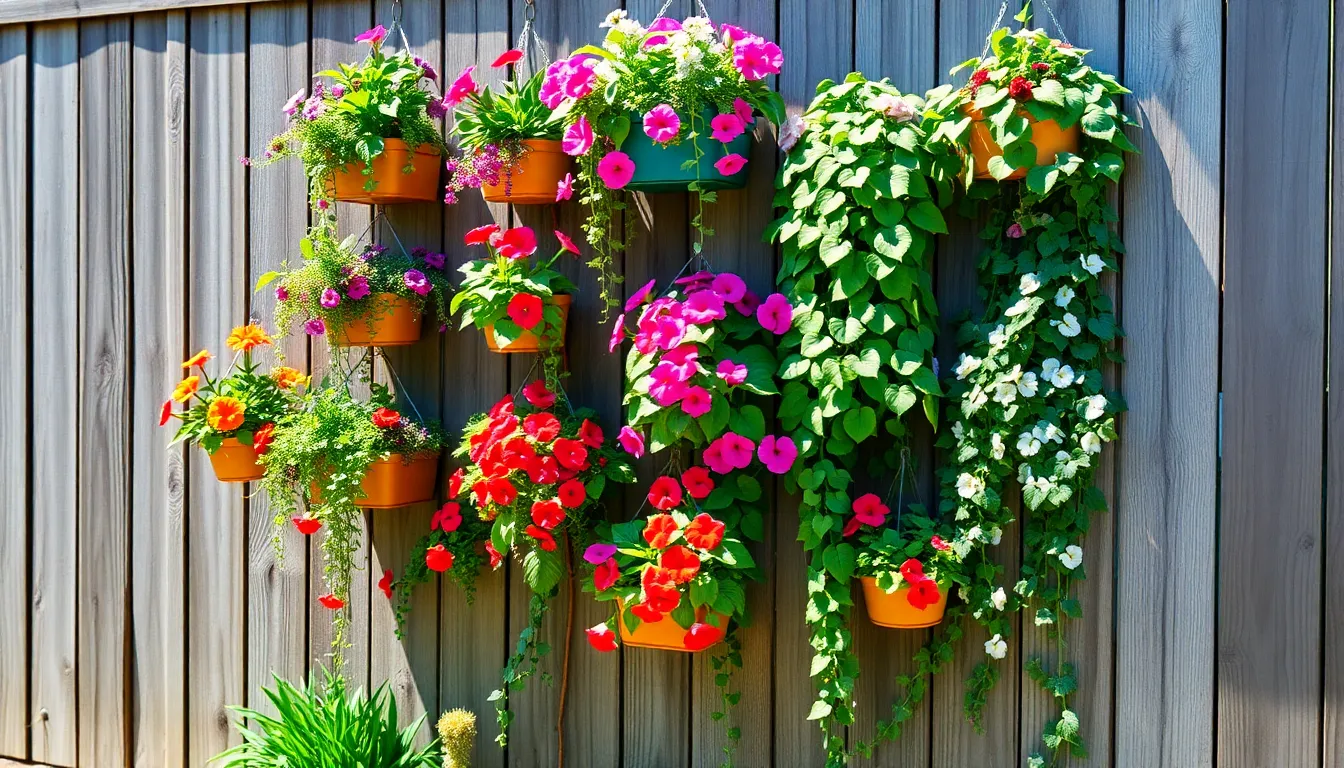
When ground space is limited, growing upwards offers unlimited potential for creating stunning garden displays. This vertical approach transforms bare walls and empty air space into vibrant growing areas.
Install Wall-Mounted Planters and Hanging Baskets
Wall-mounted planters add greenery and beauty to fences without consuming precious ground space. We can secure these directly to walls, fences, or pergola posts at various heights to create visual layers. Hanging baskets work perfectly for trailing plants like petunias, ivy, or cascading succulents that spill over the edges beautifully.
Metal wall planters withstand weather conditions while providing excellent drainage for herbs and small flowering plants. Cedar wall boxes offer a natural aesthetic that complements traditional home styles. Ceramic hanging planters bring color coordination opportunities that match your home’s exterior palette.
Position these planters at eye level near entryways to maximize their welcoming impact. We recommend spacing wall planters 18-24 inches apart to allow adequate growing room while maintaining visual cohesion.
Use Trellises for Climbing Vines and Flowering Plants
Trellises provide essential support for climbing plants like clematis and morning glories that add stunning vertical interest. We can install wooden or metal trellises against walls, fences, or as freestanding features to guide plant growth upward. These structures work exceptionally well for flowering vines that bloom throughout growing seasons.
Clematis varieties offer spectacular spring and summer flowers in purple, white, and pink shades. Morning glories provide rapid coverage with their heart-shaped leaves and trumpet flowers in blue, purple, and white. Climbing roses create romantic appeal when trained up sturdy trellis systems.
Metal trellises last longer in outdoor conditions while wooden options blend naturally with garden settings. We suggest choosing trellises that are 6-8 feet tall to accommodate mature plant growth and create impressive vertical displays.
Create Living Walls With Pocket Planters
Living walls transform vertical surfaces into lush growing spaces using specialized pocket planting systems. We mount these innovative planters directly onto walls to hold small plants, herbs, and succulents in individual compartments. This technique creates impressive green backdrops that maximize growing space dramatically.
Fabric pocket planters accommodate lightweight plants like lettuce, herbs, and small flowers while providing excellent drainage. Plastic modular systems offer durability and easy maintenance for long-term installations. These systems work perfectly for creating herb gardens near kitchen windows or decorative plant walls along property boundaries.
Succulents thrive in pocket planters because they require minimal soil depth and infrequent watering. We can combine different succulent varieties to create colorful patterns and textures across the living wall surface. Position pocket planters in areas that receive appropriate sunlight for your chosen plants’ exact growing requirements.
Design a Charming Pathway Garden
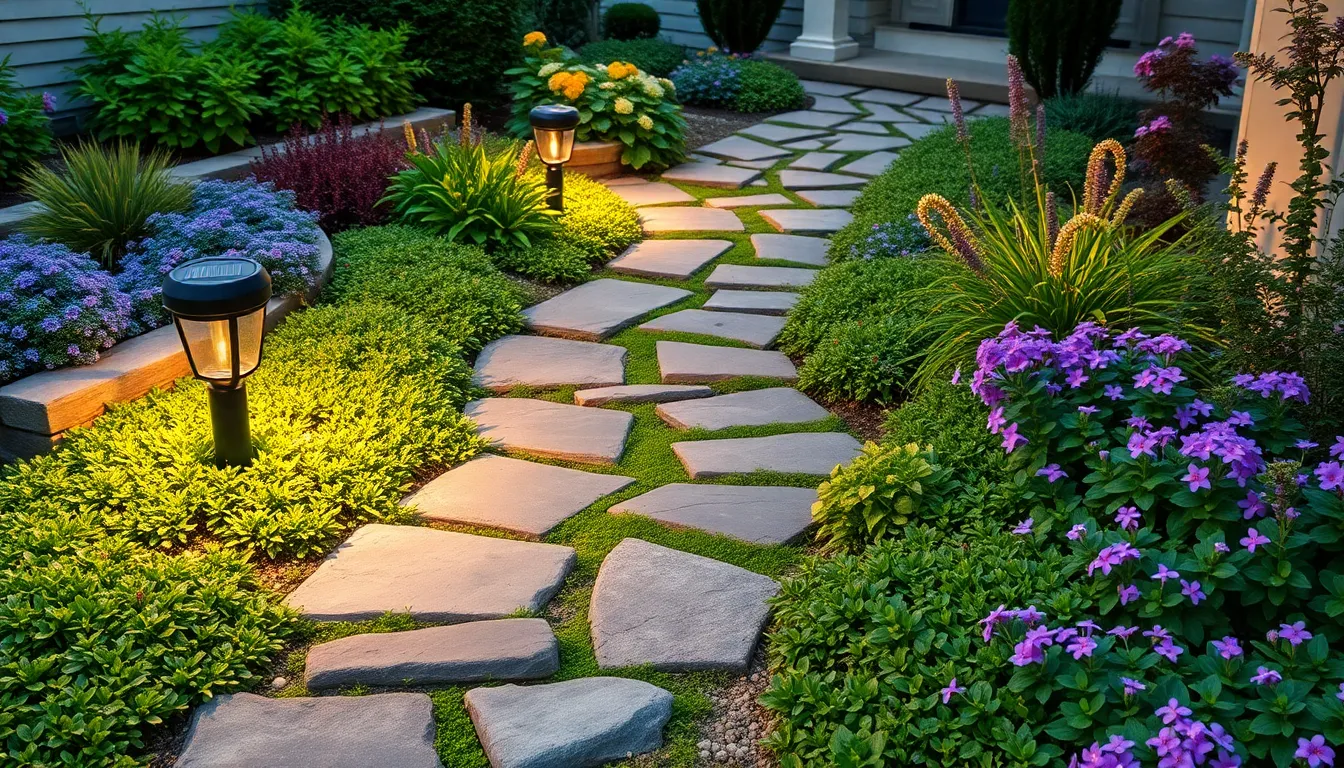
Creating pathways in small front yards transforms narrow spaces into welcoming garden experiences. We’ll show you how natural materials like wood, stone, and brick can create inviting walkways that guide visitors through your compact industry.
Line Walkways With Compact Border Plants
Select low growing plants that thrive in small spaces while adding texture and visual appeal to your pathway edges. Creeping thyme offers fragrant purple blooms and can withstand light foot traffic, while sedum varieties provide colorful foliage that changes with seasons. Moss creates a soft, lush carpet effect that works beautifully in shaded pathway areas.
Mix different textures by combining plants with varying leaf shapes and growth patterns along your walkway borders. Dwarf shrubs like boxwood provide structure and year round greenery, while compact perennials such as coral bells add seasonal color bursts. We recommend spacing these border plants 6 to 12 inches apart to ensure proper coverage without overcrowding your limited space.
Choose maintenance friendly options that won’t require frequent trimming or replacement throughout the growing season. Succulents like hens and chicks create striking geometric patterns while requiring minimal water and care. These compact plants naturally stay within their designated borders, making them perfect for small front yard pathways.
Add Solar Lighting for Evening Ambiance
Install solar powered lights along pathway edges to create dramatic evening displays without increasing your energy costs. These eco friendly fixtures charge during daylight hours and automatically illuminate your garden as darkness falls. We suggest placing lights every 3 to 4 feet along walkways for optimal coverage and safety.
Create soft lighting effects by positioning solar fixtures to highlight exact plants or decorative features along your pathway. Warm LED solar lights produce a gentle glow that enhances the natural beauty of your compact border plants without creating harsh shadows. Stake mounted options work well for illuminating ground level plantings, while taller post lights can accent focal points like small water features or decorative statues.
Focus on strategic placement to maximize the impact of your solar lighting investment in small spaces. We recommend highlighting pathway curves and elevation changes to help visitors navigate safely while showcasing your garden design. Solar spotlights can dramatically illuminate specimen plants or architectural elements, creating depth and visual interest in your compact front yard.
Incorporate Stepping Stones Through Ground Cover
Choose resilient ground covers that can handle moderate foot traffic while maintaining their attractive appearance throughout the season. Clover provides a soft, green carpet that stays lush with minimal water, while creeping juniper offers evergreen coverage with interesting texture variations. Vinca minor creates dense mats of glossy foliage with delicate purple flowers in spring.
Position stepping stones strategically to create natural walking patterns that protect your ground cover investment. We recommend spacing stones 18 to 24 inches apart to accommodate comfortable adult stride lengths while minimizing impact on surrounding plants. Flat fieldstone or concrete pavers work best, as they provide stable surfaces that won’t shift under regular use.
Design functional pathways that guide visitors through your small front yard while showcasing different garden areas. Curved stone arrangements feel more natural and create the illusion of larger space compared to straight lines. We suggest using stones of varying sizes to add visual interest, with larger pieces at key transition points and smaller ones for gentle direction changes.
Transform Your Space With a Mini Rock Garden
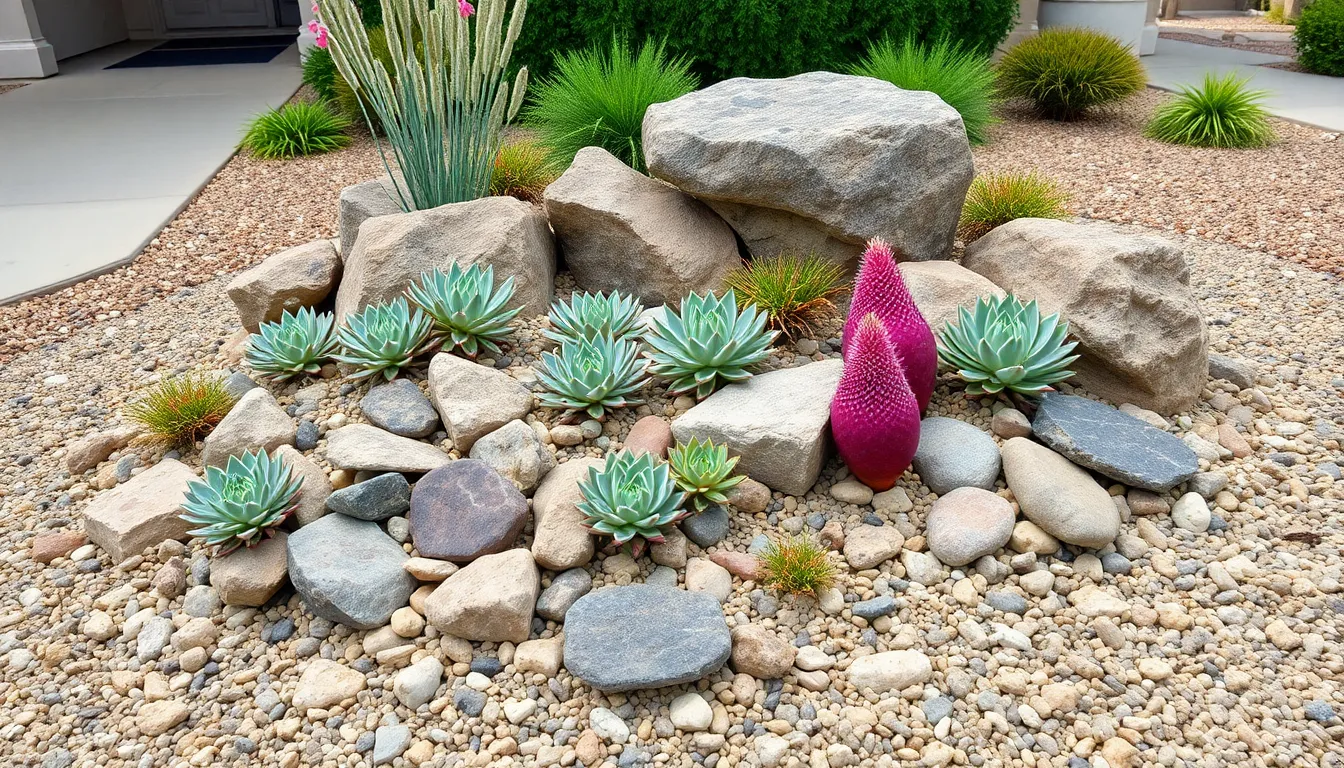
Rock gardens offer an elegant solution for transforming small front yards into low maintenance landscapes that thrive year round. We’ll show you how to create stunning visual appeal using minimal space and resources.
Select Drought-Tolerant Succulents and Alpine Plants
Drought tolerant succulents become the foundation of our rock garden design, requiring minimal watering while delivering maximum visual impact. Echeveria, sedum, and jade plants create stunning rosettes and textures that complement rocky environments perfectly. Alpine plants like creeping phlox, moss pink, and rock cress add delicate blooms without overwhelming our compact space.
Low maintenance requirements make these plant choices ideal for busy homeowners who want beautiful gardens without constant upkeep. We recommend grouping succulents with similar water needs together to simplify care routines. Native alpine varieties adapt naturally to local climate conditions and often self propagate to fill gaps between rocks.
Strategic plant placement maximizes visual interest by combining different heights, colors, and textures throughout our rock garden. Tall agave or yucca plants serve as focal points while low growing sedums carpet the ground between stones.
Use Decorative Stones and Gravel for Texture
Decorative stones and gravel create depth through contrasting colors and textures that transform ordinary spaces into sophisticated landscapes. River rocks, lava stones, and decomposed granite each offer unique visual qualities that enhance our plant selections. Light colored gravel reflects heat and brightens shadowy areas while dark stones absorb warmth to benefit cold sensitive plants.
Different stone sizes establish natural looking arrangements that mimic mountain environments and create visual flow throughout our garden. We layer larger stones as anchors then fill spaces with medium pebbles and fine gravel for professional results. Crushed granite provides excellent drainage while adding subtle sparkle that catches sunlight beautifully.
Mulching with decorative gravel suppresses weeds naturally while maintaining moisture levels around our drought tolerant plants. This approach reduces maintenance time and creates clean, finished appearances that last through all seasons.
Create Elevation Changes With Small Boulders
Small boulders establish dramatic elevation changes that make our compact front yards appear larger and more ever-changing than flat installations. We position these anchor stones to create natural terraces and planting pockets that showcase our succulent collections effectively. Boulder placement guides the eye through our garden while providing structure for climbing or cascading plants.
Strategic boulder positioning enhances visual appeal by breaking up horizontal lines and adding three dimensional interest to our industry design. Grouping odd numbers of stones creates more organic, natural appearances that avoid symmetrical formality. We nestle smaller plants around boulder bases to soften harsh edges while maintaining the rugged aesthetic.
Proper boulder installation ensures long term stability and prevents shifting during weather changes or seasonal ground movement. Partially burying larger stones creates the appearance of natural rock outcroppings while providing solid foundations for our elevated planting areas.
Establish a Cozy Seating Area Surrounded by Plants

Creating a functional outdoor living space transforms your compact front yard into an inviting retreat. We’ll show you how to maximize every square foot while building an intimate garden sanctuary.
Install a Small Bench or Bistro Set
Small benches provide the perfect foundation for your front yard seating area without overwhelming the space. Position a weather resistant wooden bench or compact bistro set strategically to serve as your garden’s focal point while maintaining easy access to your home’s entrance.
Bistro sets offer versatility with their compact footprint, typically measuring just 24 to 30 inches in diameter. Choose materials like powder coated steel or teak that withstand seasonal weather changes while complementing your home’s architectural style.
Consider placement near existing industry features to create natural conversation areas. We recommend positioning seating at least 3 feet from your home’s entrance to maintain comfortable traffic flow while establishing a distinct outdoor room within your small front yard.
Plant Fragrant Herbs and Flowers Nearby
Fragrant herbs like lavender and rosemary create sensory experiences that enhance your seating area’s appeal. Plant these aromatic varieties within 2 to 3 feet of your seating to enjoy their natural perfumes without overwhelming the space.
Lavender varieties such as English lavender thrive in most climates and provide purple blooms from late spring through summer. Rosemary offers year round greenery with small blue or white flowers that attract beneficial pollinators to your front yard garden.
Roses add classic beauty and fragrance when planted strategically around seating areas. Choose compact varieties like patio roses or miniature climbing roses that won’t outgrow your small space while delivering continuous blooms throughout the growing season.
Sunflowers bring cheerful color and natural height variation when planted behind seating areas. Select dwarf sunflower varieties that reach 2 to 4 feet tall, creating backdrop interest without blocking views or overwhelming your intimate garden setting.
Add Privacy With Tall Ornamental Grasses
Tall ornamental grasses establish natural privacy screens while adding movement and texture to your seating area. Plant varieties like fountain grass or feather reed grass that reach 4 to 6 feet in height, creating effective barriers without requiring extensive maintenance.
Fountain grass offers graceful arching foliage with attractive plumes that sway gently in breezes. This variety grows in clumps rather than spreading, making it ideal for contained spaces where you need controlled growth patterns.
Feather reed grass provides vertical structure with sturdy upright growth that won’t flop over in wind or rain. Plant these grasses in groups of 3 to 5 specimens spaced 18 inches apart to create effective privacy walls around your seating area.
Position ornamental grasses on the sides or behind your seating to frame the space naturally. We suggest avoiding placement directly in front of seating areas where the grasses might obstruct views or create closed in feelings in your compact front yard design.
Build Raised Beds for Better Organization
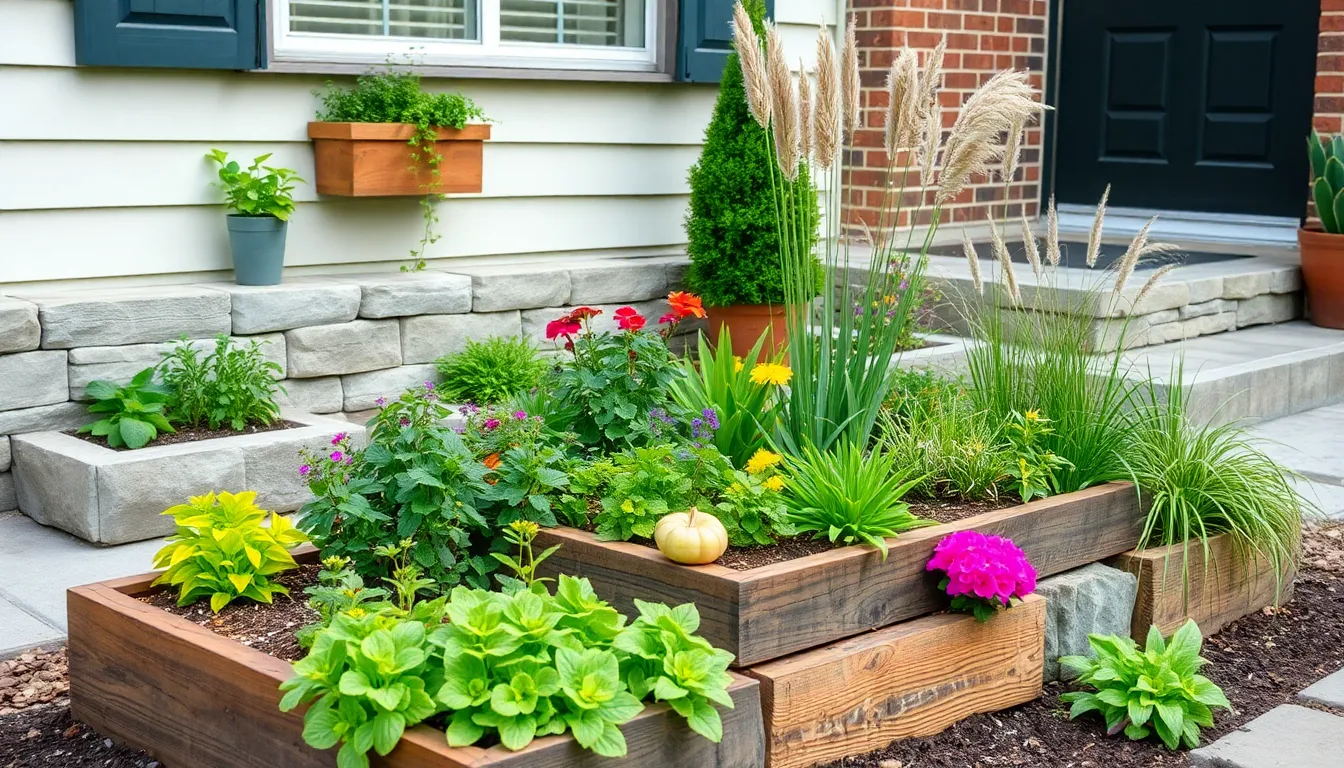
Raised beds transform small front yards into organized growing spaces that maximize soil quality and visual appeal. They help you work around challenging soil conditions while creating defined planting areas that look professionally designed.
Construct Compact Wooden or Stone Planters
Wooden planters offer versatility and warmth for small garden spaces. Cedar and redwood naturally resist decay and insects, making them ideal choices for long-lasting raised beds. Stone planters provide a more permanent and elegant solution that complements traditional home architecture.
Compact design is key when working with limited front yard space. We recommend building planters no wider than 4 feet so you can easily reach all areas without stepping on the soil. Rectangular shapes measuring 8 feet by 3 feet work perfectly for most small front yards, providing ample growing space without overwhelming the industry.
Height matters for both accessibility and drainage. Planters standing 12 to 18 inches tall reduce bending while you garden and ensure proper water drainage. Stone materials like limestone or concrete blocks create sturdy walls that last decades with minimal maintenance.
Layer Plants by Height From Front to Back
Layering creates visual depth that makes small spaces appear larger and more professionally designed. Start with low-growing plants like creeping thyme or sedum at the front edge of your raised beds. These ground-hugging varieties stay under 6 inches tall and won’t block the view of taller plants behind them.
Medium-height plants fill the middle section beautifully. Ornamental grasses like fountain grass or colorful perennials such as coneflowers work perfectly in this 18 to 24-inch height range. They provide structure and seasonal interest without dominating the entire planting bed.
Tall backdrop plants complete your layered design. Small shrubs like dwarf boxwood or flowering plants such as delphiniums reach 3 to 4 feet high, creating vertical interest. Position these taller specimens toward the back of raised beds or against walls where they won’t cast shadows on shorter plants.
Include Edible Plants Like Herbs and Small Vegetables
Herbs bring both beauty and functionality to small front yard gardens. Compact varieties like basil, oregano, and chives grow well in raised beds while providing fresh ingredients for your kitchen. Purple-leafed basil and variegated sage add ornamental value alongside their culinary uses.
Small vegetables thrive in the controlled environment of raised beds. Cherry tomatoes, lettuce, and rainbow chard produce abundant harvests while creating attractive displays. These edible plants often feature colorful foliage or interesting textures that rival traditional ornamental species.
Strategic placement maximizes both aesthetics and harvests. Position herb plants near pathways where you can easily pinch leaves for cooking. Locate leafy greens in areas with morning sun and afternoon shade to prevent bolting in hot weather. Compact root vegetables like radishes and baby carrots fill gaps between larger plants efficiently.
Incorporate Seasonal Color With Strategic Planting
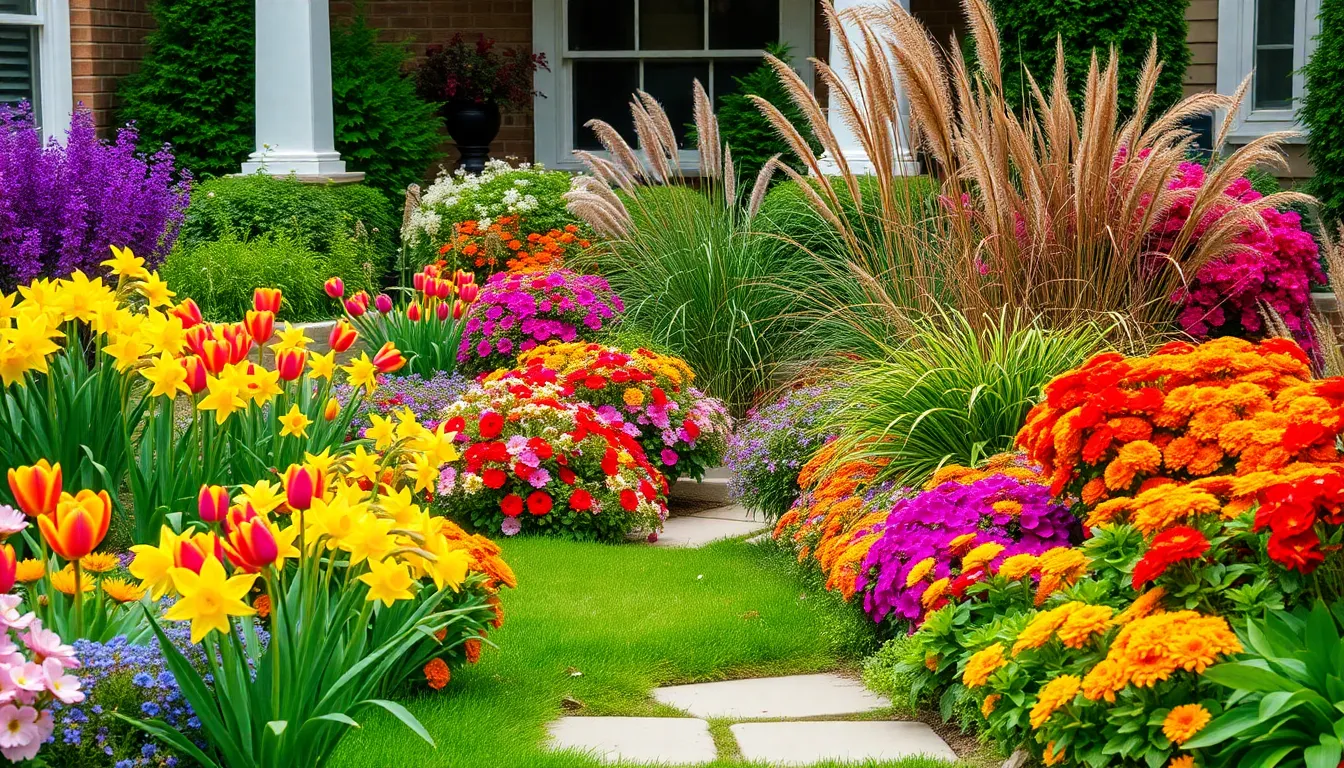
Building on our pathway and raised bed foundations, we’ll now focus on creating year-round visual interest through strategic seasonal plantings. Smart plant selection ensures our small front yards maintain vibrant appeal throughout every season.
Plan Spring Bulbs for Early Season Interest
Plant bulbs like tulips, daffodils, and hyacinths in fall to guarantee stunning early spring displays when other plants remain dormant. These hardy perennials require minimal maintenance once established and provide that crucial first burst of color after winter’s end.
We recommend selecting bulb varieties that bloom at different times throughout spring to extend the flowering season. Early bloomers like crocuses emerge first, followed by daffodils and tulips, creating successive waves of color. This staggered approach maximizes visual impact in our limited space.
Position bulbs strategically along pathway edges or within raised bed borders where they’ll receive morning sunlight. Group plantings of 5-7 bulbs together create more dramatic displays than scattered individual plantings. The natural multiplication of bulb colonies means our investment continues paying dividends year after year.
Choose Summer Annuals for Continuous Blooms
Summer annuals like petunias, marigolds, and zinnias deliver non-stop flowering performance throughout the hottest months when consistent color matters most. These reliable bloomers thrive in containers and raised beds while requiring minimal care beyond regular watering.
Select annuals with complementary bloom times to maintain continuous color from late spring through early fall. Heat-tolerant varieties like portulaca and celosia excel in sunny locations, while impatiens and begonias provide vibrant options for shadier spots near our seating areas.
Deadheading spent blooms encourages continued flowering and keeps plants looking fresh throughout the growing season. This simple maintenance task, performed weekly, dramatically extends the blooming period and maximizes our seasonal color investment.
Select Fall Foliage Plants for Autumn Appeal
Incorporate plants with spectacular fall foliage like maples, oaks, or burning bush to transform our front yards into autumn showcases. These deciduous specimens provide structure during growing season while delivering breathtaking color displays when temperatures drop.
Ornamental grasses like fountain grass add movement and texture while developing golden or burgundy hues in fall. Their seed heads persist through winter, extending visual interest beyond the typical growing season and providing food sources for local wildlife.
Strategic placement of fall foliage plants creates focal points that draw attention during autumn months when many other plants begin declining. Position these specimens where morning or afternoon light will illuminate their changing leaves, maximizing the dramatic impact of their seasonal transformation.
Add Visual Height With Small Trees and Large Shrubs
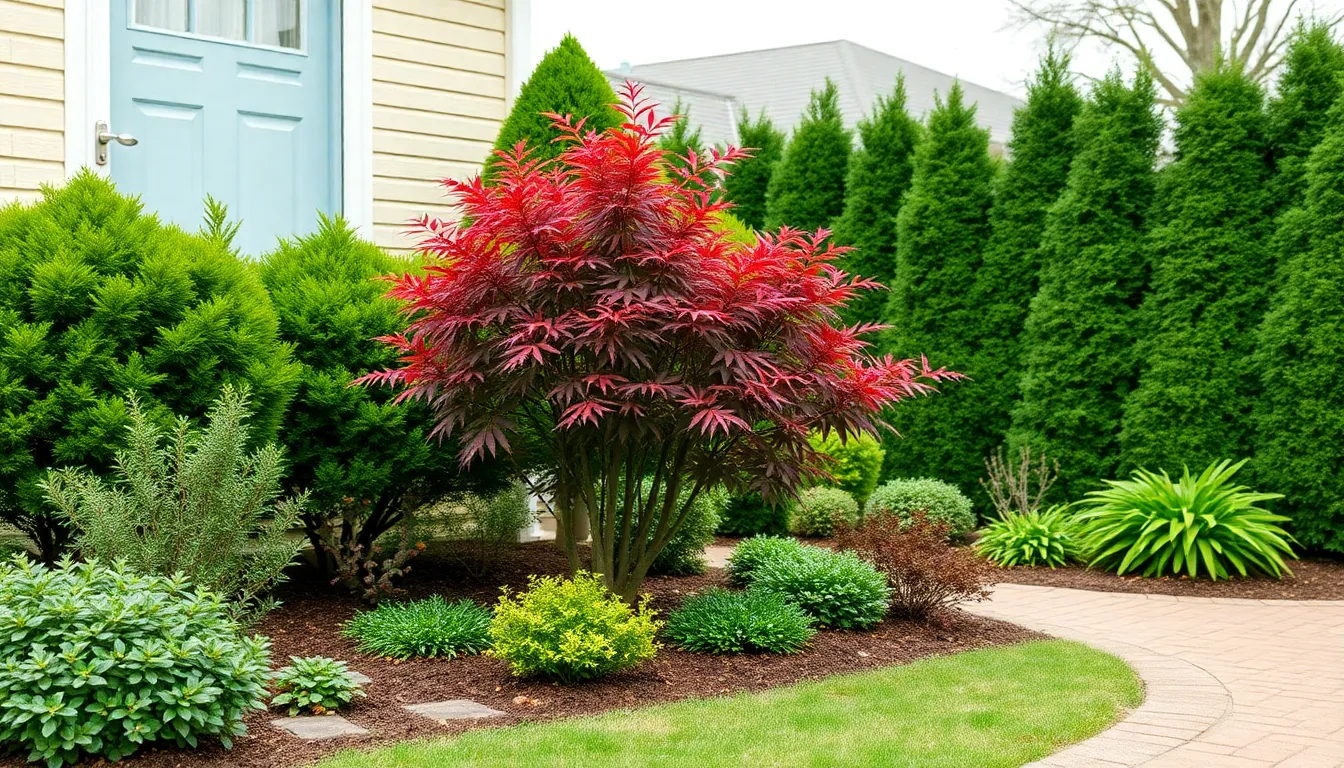
Building on our foundation of raised beds and seasonal plantings, we’ll now explore how vertical elements can transform your small front yard into a ever-changing industry. Strategic placement of trees and shrubs creates the visual depth that makes compact spaces feel larger and more captivating.
Plant Compact Ornamental Trees as Focal Points
We recommend selecting dwarf Japanese maples or compact flowering dogwoods as stunning centerpieces for your small front yard. These trees serve as natural anchors that draw the eye upward while maintaining appropriate scale for limited spaces. Position your focal tree slightly off center to create visual balance and avoid a rigid, symmetrical look that can make small yards feel cramped.
Compact ornamental trees provide year round interest through seasonal changes in foliage, flowers, and bark texture. Dwarf varieties typically reach heights of 8 to 12 feet at maturity, making them perfect for front yard applications where overhead power lines or building proximity might restrict larger specimens. We suggest choosing trees with multiple seasons of appeal, such as redbud varieties that offer spring blooms, summer foliage, and interesting winter branching patterns.
Use Dwarf Varieties to Maintain Scale
Dwarf shrubs and miniature plant varieties prevent your small front yard from feeling overcrowded while still providing rich texture and color diversity. These compact plants fit naturally into confined areas and require less maintenance than their full size counterparts. We recommend using dwarf boxwood for evergreen structure, compact hydrangeas for seasonal blooms, and miniature hostas for shaded areas.
Proportionality becomes crucial in small spaces where oversized plants can quickly overwhelm the entire design. Dwarf varieties allow us to layer different plant heights and textures without sacrificing precious square footage. Small topiary forms add formal elegance while maintaining the intimate scale that makes front yard gardens feel welcoming rather than imposing.
Position Larger Plants as Natural Screens
Strategic placement of larger shrubs and small trees creates privacy barriers that feel organic rather than constructed. We position these natural screens near property boundaries or alongside walkways to establish a sense of enclosure without making the space feel cramped. Evergreen shrubs like compact arborvitae or dwarf spruce varieties provide year round screening while maintaining appropriate scale.
Larger plants also serve as backdrop elements that frame smaller ornamental features and seasonal displays. Positioning taller specimens toward the back or corners of your yard creates natural boundaries that guide the eye through your garden design. These living screens offer the added benefit of filtering noise from busy streets while creating microclimates that can protect more delicate plants from harsh winds or intense sun exposure.
Create Definition With Garden Borders and Edging
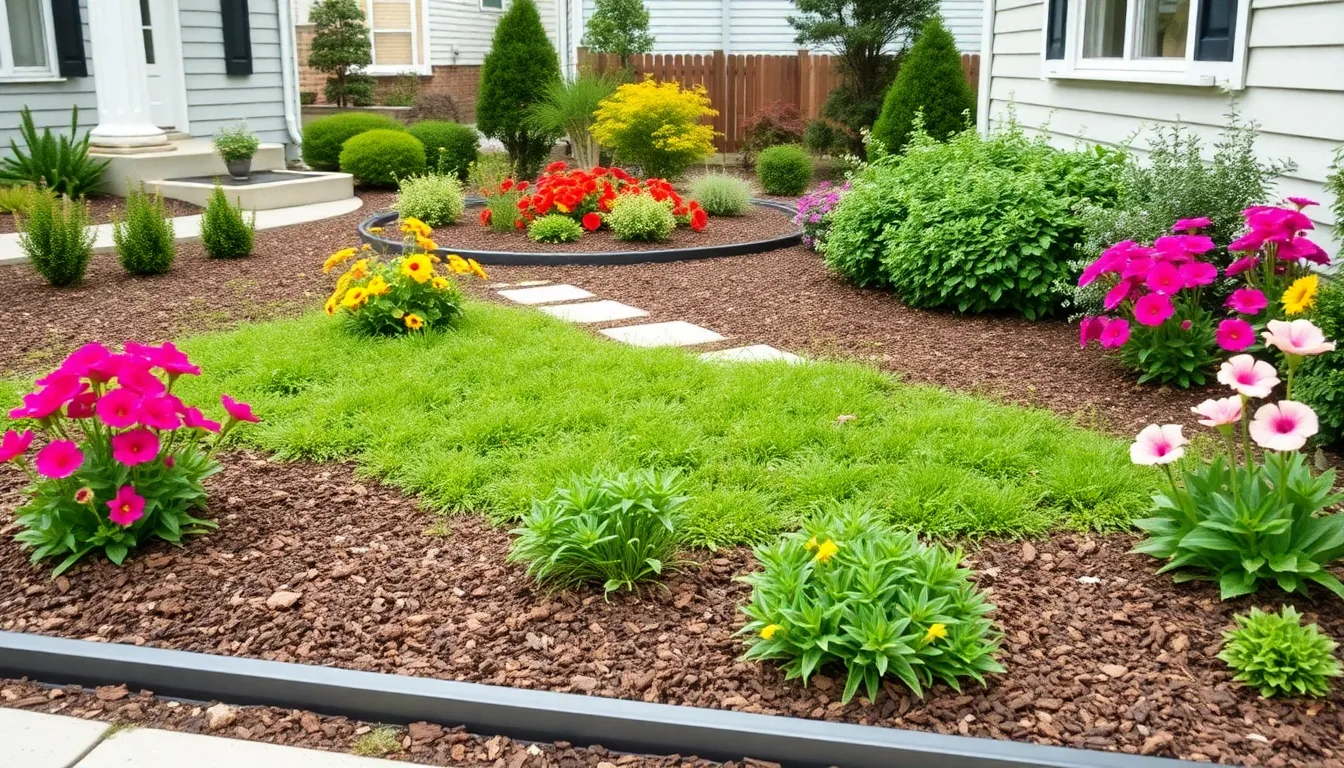
Well-defined borders transform chaotic small front yards into organized, professional-looking landscapes. Creating clear boundaries between different garden elements helps maximize your limited space while improving overall curb appeal.
Install Clean Lines With Metal or Stone Borders
Metal edging delivers sleek, modern lines that visually separate your lawn from flower beds and pathways with precision. We recommend installing these durable borders to create sharp definition that makes small spaces appear larger and more intentional. Steel and aluminum options provide long-lasting answers that won’t shift or deteriorate over time like plastic alternatives.
Stone borders offer a natural, rustic appearance that complements traditional and cottage-style landscaping beautifully. Natural materials like fieldstone, river rock, or cut limestone create permanent boundaries that age gracefully while maintaining their structural integrity. These materials work particularly well around curved garden beds where their organic shapes follow flowing lines naturally.
Both metal and stone options help contain mulch and soil while preventing grass from creeping into your carefully planned flower beds. Installation requires minimal maintenance once properly set, making them ideal choices for busy homeowners who want professional results without ongoing upkeep.
Use Low-Growing Plants to Define Spaces
Low-growing plants create natural borders that add greenery without overwhelming your compact front yard design. We suggest using plants under 12 inches tall like creeping thyme, moss phlox, or dwarf boxwood to establish boundaries while keeping sight lines open and unobstructed.
These living borders maintain a neat, structured appearance while providing seasonal interest through flowers, foliage changes, or evergreen consistency. Repetition of the same plant species along borders creates visual unity that makes small spaces feel cohesive and well-planned rather than scattered or random.
Strategic placement of these compact plants along walkways, around trees, or between different garden zones helps guide the eye through your industry design. Their controlled growth habits ensure they won’t outgrow their designated spaces or require frequent trimming to maintain their intended shape and size.
Add Mulch for a Polished, Finished Look
Mulch provides the finishing touch that ties your entire front yard design together with professional polish. We recommend applying 2-3 inches of organic mulch like shredded bark, wood chips, or compost around your planted areas to create clean, uniform surfaces that suppress weeds naturally.
Color contrast becomes a powerful design tool when you choose mulch that complements your plant selections and hardscape materials. Dark mulches like cocoa shells or black bark make colorful flowers pop visually, while lighter options like cedar chips create subtle backgrounds that won’t compete with delicate foliage.
Proper mulching retains soil moisture and regulates temperature around plant roots, reducing your watering needs while promoting healthier growth. This practical benefit extends beyond aesthetics, helping your small front yard plantings thrive with less maintenance throughout the growing season.
Conclusion
We’ve shown you that small front yards hold incredible potential for creating stunning outdoor spaces. With the right combination of vertical gardening answers raised beds seasonal plantings and strategic design elements you can transform even the tiniest area into a welcoming industry.
Remember that success lies in maximizing every square inch through thoughtful plant selection proper lighting and well-defined borders. These proven techniques we’ve shared will help you create a front yard that not only looks beautiful year-round but also adds important value to your home.
Start with one or two ideas that resonate most with your style and space. You’ll be amazed at how quickly your small front yard becomes the envy of the neighborhood.
Frequently Asked Questions
What are the best container plants for small front yards?
Choose low-maintenance perennials and evergreens for year-round appeal. Popular options include succulents, lavender, rosemary, and dwarf shrubs. These plants require minimal watering and provide continuous color and texture. Use weather-resistant planters in various sizes, arranging them at different heights with odd-numbered groupings for maximum visual impact.
How can I make my small front yard look bigger?
Use vertical gardening solutions like wall-mounted planters and trellises to grow upwards instead of outwards. Create curved pathways with stepping stones, install tiered container arrangements, and use light-colored mulch. Strategic placement of small boulders and varying plant heights also creates the illusion of more space.
What are the best low-maintenance plants for small spaces?
Drought-tolerant succulents like Echeveria, alpine plants such as creeping phlox, ornamental grasses, and herbs like thyme work excellently. These plants require minimal watering and care while providing maximum visual impact. Combine them with evergreen shrubs for structure and year-round interest.
How do I create privacy in a small front yard?
Plant tall ornamental grasses like fountain grass and feather reed grass to create natural barriers. Use larger shrubs as backdrop elements and install trellises with climbing vines. These solutions add privacy while maintaining the garden’s aesthetic appeal and preventing the space from feeling cramped.
What’s the best way to add lighting to a small front yard?
Install solar-powered lights along pathways to highlight plants and decorative features while ensuring safety. Focus on strategic placement to maximize impact in compact spaces. Uplighting small trees and accent lighting for containers create ambiance without overwhelming the limited space.
How wide should raised beds be in small front yards?
Keep raised beds no wider than 4 feet for easy access and maintenance. This width allows you to reach all plants without stepping into the bed. Use compact wooden or stone planters, and layer plants by height with low-growing plants in front and taller backdrop plants at the back.
When should I plant bulbs for spring color?
Plant spring bulbs like tulips, daffodils, and hyacinths in the fall before the ground freezes. Choose varieties with staggered bloom times to extend the flowering season from early spring through late spring. This creates continuous color when other plants are still dormant.
What materials work best for small yard pathways?
Natural materials like wood, stone, and brick create inviting walkways that complement small spaces. Line pathways with compact border plants such as creeping thyme, sedum, or moss for added texture. Use curved arrangements to create the illusion of larger space.


